March 16, 2007
Air Date: March 16, 2007
FULL SHOW
SEGMENTS
EU Leads the Way
View the page for this story
The European Union approved an agreement that would require member states to invest in renewable energies and reduce greenhouse gas emissions to certain target levels. The Economist correspondent Vijay (Vee-Jay) Vaitheeswaran (Vie-thee-swa-ran) analyzes the treaty, along with a bold bill put forth by the United Kingdom, and the challenge they present to the United States and other large carbon-emitting countries. (06:45)
Refocusing the Evangelical Family
View the page for this story
Leaders from the National Association of Evangelicals have come under fire from conservative evangelicals for adding climate change to their political agenda. Scientist and evangelical Calvin DeWitt talks with host Steve Curwood about the implications of this schism among evangelicals. (04:45)
Capturing Carbon
/ Jeff YoungView the page for this story
Will new technology allow us to keep coal power from warming the planet with its greenhouse gas emissions? Living on Earth's Jeff Young visits two very different coal-powered plants to feel the burn. (07:30)
Not the Swimsuit Edition
View the page for this story
Sports Illustrated’s recent cover story documents the effects of climate change on the sporting industry, and it’s not just a problem for dogsledders. Athletes in sports ranging from nordic skiing to football are changing the way they play to adapt to a changing climate. Host Steve Curwood speaks with David Epstein, co-author of “Going, Going Green.” (05:15)
Emerging Science Note/Watch Your Step!
/ Paige DoughtyView the page for this story
Living on Earth’s Paige Doughty reports on the prospects of turning cow manure into flooring. (01:30)
Polling the People
View the page for this story
A new survey shows that 63 percent of Americans are as concerned about climate change as they are about terrorism. Host Steve Curwood talks with Professor Daniel Esty, director of the Yale Center for Environmental Law and Policy, which commissioned the survey. (04:30)
The Language of Landscape
/ Barry LopezView the page for this story
Learn the meaning of the term “blind creek” from Barry Lopez, who edited the essay collection: “Home Ground: Language for an American Landscape”. (02:00)
Home Invasion, Baboon-style
/ Steve CurwoodView the page for this story
There’s a battle underway in the suburbs of Cape Town, South Africa: people versus baboons. Troupes of baboons are roaming suburban neighborhood streets, looking for food and scaring residents. In some cases, they’ve broken windows and locks to raid kitchen cabinets. As host Steve Curwood reports, there’s fierce debate over how best to keep the baboons away from people. (15:30)
Show Credits and Funders
Show Transcript
HOST: Steve Curwood
GUESTS: Calvin DeWitt, David Epstein, Daniel Esty, Barry Lopez, Vijay Vaitheeswaran
REPORTER: Jeff Young
SCIENCE NOTE: Paige Doughty
[THEME]
CURWOOD: From Public Radio International - this is Living on Earth.
[THEME]
CURWOOD: I’m Steve Curwood.
Europe is leading the way on plans to reduce global warming gases and the UK is leading Europe. The government of Tony Blair plans to lock in a sixty percent reduction in carbon emissions by mid-century.
VAITHEESWARAN : I think Tony Blair is the unheralded hero of the fight against climate change. I think history will be very much kinder to him on this issue than it is at the moment. But this new bill is actually the most important piece of his legacy.
CURWOOD: Here in the US, a quarrel over climate change may reveal a power shift among evangelical Christians.
DEWITT: We’re seeing the exit of the old guard who have dissociated themselves from the actual scientific and the experiential conclusions that are very easy for most everyone in the world to draw today.
CURWOOD: Those stories, plus cleaning up coal, and more on Living on Earth. Stick around!
[MUSIC]
[NPR NEWSCAST]
ANNOUNCER: Support for Living on Earth comes from the National Science Foundation and Stonyfield Farm.
EU Leads the Way
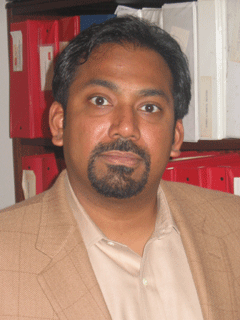
Vijay Vaitheeswaran (Courtesy of Vijay Vaitheeswaran)
CURWOOD: From the Jennifer and Ted Stanley Studios in Somerville, Massachusetts - this is Living on Earth. I’m Steve Curwood.
There’s big news out of Europe on climate change policy. First, the Labor Government of the UK led by Tony Blair has formally filed legislation that would cut Britain’s global warming gases by 60 percent by the year 2050. The bill has yet to be enacted but under the British parliamentary system such a majority measure almost always becomes law.
In the meantime a summit meeting of the European Union has led to a commitment to reduce the E.U’s total global warming gases by at least twenty percent over 1990 levels within thirteen years—raising the ante from the EU’s more modest commitment under the Kyoto Protocol.
The moves put the UK and the other 26 countries of the European Union onto a much faster track toward a new energy economy. And it puts them far out ahead of the world's largest contributors to global warming, countries like the U.S. and China.
Joining us to discuss these developments is Vijay Vaitheeswaran. He’s a correspondent for the The Economist magazine. Vijay, thanks for joining us.
VAITHEESWARAN: Hello there, good to be with you.
CURWOOD: So what did the EU decide to do?
VAITHEESWARAN: The gathered heads of state from across Europe agreed on a plan for greenhouse gasses that goes beyond the current Kyoto treaty, which is about to expire. And they also agreed on targets for renewable energy, on biofuels for the transportation sector. And they even talked a little bit about if the rest of the world, which is subtext for the United States, gets on board they might even have a plan for the next round of Kyoto, how to go even further ahead on tackling climate change.
CURWOOD: Alright, let’s look at those. What’s their plan to go forward for the next round of Kyoto if the United States can get engaged?
VAITHEESWARAN: Well if the world joins on board and the US will insist China does something. So you can say in a way those are the two litmus tests. Europe is ready to cut its green house gas emissions by 30 percent below the level they were at the 1990s. Now what they say is even if the US does nothing they’re still going to cut by 20 percent over the next 15 years, by 2020.
CURWOOD: Early on it was easy for countries like the UK to say they were going to reduce emissions below 1990 levels because in fact they had already. But now-a-days the EU is a lot bigger. You’ve got states like Poland and the Czech Republic that are using a lot of very cheap coal and oil and aren’t particularly set up to meet the goals of this EU proposal. How are they going to be able to fit into this?
VAITHEESWARAN: Well, you asked absolutely the right question. The key is coal, just as it is in looking at the global climate picture. When you look at Eastern Europe, Poland for example, was very vocal at this summit as were some of the Eastern European countries that rely on dirty fuels. They said, “Look we’re poor and we need to grow. And we have lots of domestic coal and equally important we don’t want to become reliant on Russian gas imports.” And so what they got the richer, more environmentally minded Western European countries to agree to was a language that said all of Europe will embrace a target of 20 percent renewables by 2020 but we won’t dictate to individual countries what their target should be. And that allows them some wiggle room.

Vijay Vaitheeswaran (Courtesy of Vijay Vaitheeswaran)
VAITHEESWARAN: The technologies are there, there’s no question. Denmark for example is a world leader in the wind industry. We have, Germany is now the world’s largest market for solar, thanks to massive subsidies of course. And we have, if you want to talk about a very controversial low carbon technology, France is probably the world’s leader on nuclear power, ah, which they managed to sneak into this treaty as a footnote. We might even see this treaty unravel in a way if the definition of renewables goes the way that France wants so that renewables includes nuclear power.
But all this goes to say that they have a multiplicity of technologies available. The real question is how expensive will they be? They’re going into the unknown. There’s good reason to think that the costs will not be high, that, you know, they’ll build new industries. Europe could even be the world leader in many of these fields. But you can’t prove that before the fact so it is something of a risk.
CURWOOD: Now, what about the UK’s move, this call for a 60 percent reduction by 2050, ah, has been announced as a goal but now there’s an actual tangible bill to do this. What does that bill exactly entail?
VAITHEESWARAN: I think Tony Blair is the unheralded hero of the fight against climate change. I think history will be very much kinder to him on this than it is at the moment. Ah , but this new bill is actually the most important piece of his legacy because it translates into law, assuming the bill is passed. Specific five year plans, carbon budgets that would be drafted by independent board of experts; imagine something like the Federal Reserve Bank in the US. They would say what is a reasonable target for Britain in the next five years and Britain would pass it into actual laws with teeth.
And more than five years out, they would actually pass the next three five-year plans, meaning businesses would have 15 years of legal certainty. I mean that is astonishing. That is money in the bank as far as industry is concerned. Because the thing that’s holding up investment in green energy more than anything else is uncertainty. Business can’t invest in a power plant when you don’t know for example, what Washington’s gonna do. So businesses actually hate uncertainty even more than they hate regulation. And what Tony Blair’s new bill, assuming it goes into law at some point, will give Britain a dramatic advantage and give British industries a dramatic advantage in entering a low carbon age.
CURWOOD: In some sense then, Vijay, this summit of the EU leaders and the British bill, does it mean in a broad picture?
VAITHEESWARAN: I think this really sets the stage for how we will look beyond Kyoto to a more sensible global round of international climate negotiations. Germany has the presidency of the European Union at the moment and will also be chairing the very important G-8 summit, which includes of course the United States, and the chancellor of Germany has made it very clear she’s putting a lot of political clout on the line. And especially given that her own car companies are very reluctant to do this she’s showing great political courage. And I think that actually moves the bar and makes it hard for President Bush and any future American administration to do so little on climate change.
CURWOOD: Vijay Vaitheeswaran is a correspondent in Washington for The Economist. Thank you so much sir.
VAITHEESWARAN: It’s a great pleasure.
Related links:
- EU's webpage on climate
- Draft of the UK's Climate Change Bill
Refocusing the Evangelical Family

Calvin B. DeWitt (Courtesy of the University of Wisconsin-Madison)
CURWOOD: Here in the U.S., the call for action on global warming by the National Association of Evangelicals has come under fire from Christian conservatives. The conservatives, including James Dobson, Gary Bauer and Paul Weyrich fired off a letter to the 30 million-member association demanding that it dismiss its lead spokesman on climate change, the Reverand Richard Cizik.

James Dobson (Courtesy of Focus on the Family)
He’s President of the Academy of Evangelical Scientists and Ethicists, as well as a professor of Environmental Studies at the University of Wisconsin in Madison. And Hello Sir.
DEWITT: Hello, good to be with you, Steve.
CURWOOD: Now explain to us what’s going on in the nation’s evangelical movement around this question of climate change. To what extent does this represent some sort of schism now in the evangelical movement?
DEWITT: Well, I’ve been watching this of course for a long time, and actually what’s happening is, whatever schism there was, is being lessened and lessened, and the way I see this myself, personally, is I kind of pass gasp by those who are really trying to hold on to the claim that global warming is not real. If it is there at all we’re not responsible for it. And this is flying of course right in the face of our knowledge of things.
And the young people I deal with amongst them there are none that are thinking along these lines. And I think what we’re doing is we’re seeing the exit of the old guard who are certainly very dedicated to their purposes but I think they, they rather consciously have disassociated themselves from the actual scientific and the experiential conclusions that are very easy for most everyone in the world to draw today.
CURWOOD: So what are the hidden differences behind the feud? I mean the letter says that evangelicals should focus their political energy on moral issues like the integrity of marriage, read homosexuality, the teaching of sexual abstinence and the sanctity of human life, that is the abortion question. Why does climate change bother theses guys so much?
DEWITT: Uh, that’s a good question. I puzzle over it, especially I know they may not realize that areas like Bangladesh are so subject to flooding. If that’s not a moral issue is because that involves just millions and millions of people. To neglect the people who are being displaced, because you’re saying we only must focus on issues that we define, is rather surprising.
CURWOOD: Evangelicalism became synonymous with conservative and Republican values based around the questions of abortion and family, very vigorous political participation. Now, with this widening to include things like climate change how much will that political activism continue and how much of it will be particularly aligned with one party?

Calvin B. DeWitt (Courtesy of the University of Wisconsin-Madison)
CURWOOD: How influential do you think the evangelical movement is going to be in the political change around climate change in this country, if the evangelicals, which represent what, 100 million Americans? If this is opening up has America changed its mind now about climate change?
DEWITT: Well, I think we’re in a transition and its major root is in 60 or so evangelical colleges and universities where we have, not only the religious teaching, but we also have scientists in each of these 60 colleges, and, um, that’s providing a very solid scientific, biblical, theological root that’s not easily disturbed any more. So the evangelical world in a very real way is maturing in terms of its knowledge and understanding of the world. And ah, that’s one thing that you do as an evangelical is you do seek the truth and when you understand the way the world works you move on and say, “ok, now what must we do?” And what we must do now is care for creation and I suppose it means we start at our very local place and build out from there.
CURWOOD: Calvin DeWitt is President of the Academy of Evangelical Scientists and Ethicists. Thank you so much sir.
DEWITT: You’re welcome.
CURWOOD: You can hear more of this interview at loe.org.
[MUSIC: Slowblow “Frank’s Theme” from ‘Kitchen Motors Family Album’ (Kitchen Motors - 2007)]
Related links:
- The Letter to the National Evangelical Association
- National Association of Evangelical's board meeting following the letter
- Creation Care
- To listen to a longer version of the interview with Calvin DeWitt click here
CURWOOD: Just ahead it’s manure, but your shoes won’t mind. A renewable flooring product made from cow pies. Keep listening to Living on Earth.
[MUSIC: Amon Tobin “Esther’s” from ‘Foley Room’ (Ninja Tune – 2007)]
Capturing Carbon

(Phillip J. Redman, U.S. Geological Survey)
CURWOOD: It’s Living on Earth. I’m Steve Curwood.
Some call it a “coal rush.” Plans are on the table for electric utility companies to build some 150 new coal-fired power plants in the U.S. Coal is a plentiful domestic source of energy, but all those new power plants could bring a spike in carbon dioxide pollution—a chief culprit in global warming. So scientists are looking for new ways to use this old fuel. One promising approach is called “carbon capture and sequestration.” It would take the CO2 out of power plant emissions and store it deep in the earth. Living on Earth’s Jeff Young looks at how coal might be made more climate friendly.
The story is part of our occasional series, “Generating controversy: the changing climate of coal.”
YOUNG: Walking into the Dominion power station at Mount Storm, West Virginia, feels like entering the belly of the beast.
WOOD: Alright put your ear plugs in.
[ROAR OF MACHINERY]
YOUNG: Massive grimy machines feed 15 thousand tons of coal a day to giant boilers. Plant manager Bill Wood shouts above the roar of pure, raw power.

Dominion's Mt. Storm Power Station (Courtesy of Dominion)
YOUNG: Pulverized coal burners like this one dominate the power industry today. This old workhorse powers almost a million homes and has done so for 40 years.
[PASSING THROUGH DOOR PEOPLE GREETING]
YOUNG: In the control room we take out the earplugs and Wood points to a throbbing yellow glow on a monitor screen.
WOOD: When you’re talking about the boilers. We’ve actually got furnace cameras showing the fireball inside the boilers.
YOUNG: Wow, look at that. Man it’s like looking at the sun or something!
WOOD: It’s pretty intense. That fireball at it’s hottest point is probably in the neighborhood of 2,700 degrees Fahrenheit
YOUNG: You’re kind of looking straight into the heart of what your whole industry’s all about, right there.
WOOD: That’s right. We generate steam.
YOUNG: They also generate a lot of carbon dioxide, the main greenhouse gas. A power plant this size can pump out more than six million tons of CO2 a year. There are ways to teach old dogs like Mount Storm the new trick of fetching CO2. One method binds up carbon in the exhaust with ammonia. Another sends pure oxygen into the boiler. Both would likely be very costly, raising the price of electricity as much as 50 percent. Climate scientists say building a whole new fleet of these old style power plants without any carbon capture technology could be a climate disaster. Princeton University professor Robert Socolow compares it to trains on a collision course.
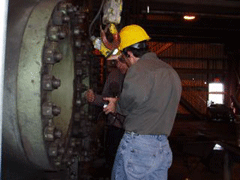
(Courtesy of Jeff Young)
SOCOLOW: Train number one is the rush to coal power; train number two is the urgency of dealing with climate change. The switch is carbon capture and sequestration, or CCS.
YOUNG: Socolow told a congressional committee that carbon capture and sequestration technology is urgently needed and ready for full-scale deployment. After the hearing Socolow told me that one form of carbon capture stands out from the rest.
SOCOLOW: The surest way to move forward is to build IGCC plants that seems, by general agreement, to be what we can do today and will be the cheapest route.
YOUNG: IGCC is a cleaner kind of coal power that could provide an easier way to remove carbon dioxide. To understand how, we first need to know what IGCC is: integrated gasification combined cycle. That’s quite a mouthful. But the part to focus on is the “G” —the gasification. That is the key difference.
HORNICK: We don’t burn coal, in terms of combusting it, which is the normal way of doing it, we gasify coal.

Jeff Young gets the tour of Tampa Electric's Polk Power Station from Plant Manager Mark Hornick.(Courtesy of Jeff Young)
HORNICK: We actually turn that solid fuel into a gaseous fuel before we use it in combustion turbines. And that’s what the gasification is all about.
YOUNG: The IGCC plant is a totally different animal from the old pulverized coal burner at Mount Storm. There’s no plume from a smokestack, no boiler with a glowing fireball. Gasification begins when a coal slurry is injected with oxygen into a high-pressure environment to create a gas. A turbine burns it to make power. But before that, pollutants like sulfur and particulates are stripped from the pressurized gas, and that’s much easier than dealing with the exhaust from a boiler. Hornick says that same method could be used to strip out CO2 as well.
HORNICK: Well it wouldn’t be small deal. But it’s certainly something that’s doable and proven in IGCC. If you’re gonna do CO2 removal from any plant it is gonna increase cost. For IGCC they estimate about a 25% increase, which is not insignificant. However if you look at conventional coal it would be over 50% and technology is a lot less proven.
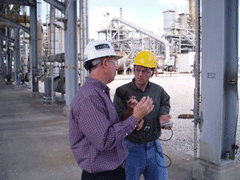
(Courtesy of Jeff Young)
IGCC plant to do it in three or four years—that’s remarkably fast in the world of power plants. And once captured the CO2 has to go somewhere. In some places it’s used to force oil and gas from old wells. It can also be pumped deep into formations in the earth where high pressure makes it a liquid. Small scale tests show the liquid CO2 stays underground.
A new study by MIT called “The Future of Coal” found most parts of the country could store large amounts of CO2. MIT chemistry professor John Deutch praises IGCC as a clean option for coal power but does not declare it the technological winner. Deutch served in both the US Department of Energy and CIA. He advocates much more research and development for all kinds of carbon capture and sequestration. He says current government spending doesn’t come close.
DEUTCH: We think that’s an urgent, urgent program for the Department of Energy to undertake, in this country, and for other countries to undertake around the world.

(Photo: Phillip J. Redman, U.S. Geological Survey)
MARKEY: You know, Saint Augustine used to say, “Oh lord make me chaste but not just yet.” These utility executives are saying, “Oh lord make me carbon free but not just yet.”
YOUNG: Markey leads a new special congressional committee on global warming and he’s pushing for a law to regulate greenhouse gas emissions. Without that, he says, it’s doubtful companies would pay to take the carbon out of coal.
For Living on Earth I’m Jeff Young in Washington D.C.
[MUSIC Paper “Floodlines” from ‘Mind Expansion Compilation’ (Revolver - 2002)]
Related links:
- To view MIT’s study “The Future of Coal," click here
- Tampa Electric’s IGCC power plant
- Princeton’s Carbon Mitigation Initiative
Not the Swimsuit Edition

SI Cover (Courtesy of Sports Illustrated)
CURWOOD: The recent issue of Sports Illustrated Magazine has a provocative picture on its cover and no, it’s not a model in a swimsuit. It’s Florida Marlins ace pitcher Dontrelle Willis, standing in the outfield of his home stadium up to his thighs in water. It’s a virtual image, of course, but it’s a stark representation of the threat that climate change poses to places like Miami and to the world of sports—something that’s supposed to be an escape from “real life.”
The cover story is titled: Going, Going Green and it documents the way global warming is already affecting sporting events from skiing to dog-sledding to football. Reporter David Epstein is co-author of the article and he joins me now from the offices of Sports Illustrated in New York City. Hello David.
EPSTEIN: Hi.
CURWOOD: Give me some examples of how climate’s affecting athletes and their sports.
EPSTEIN: Well, I mean everything from when we have an extraordinarily hot summer, even when it’s just a couple of degrees makes a big difference for say high school football players. I mean I talked to some coaches, Texas high school football, and they said, you know Texas high school used to be famous for this kind of two-a-day sweating players into shape stuff. And now it’s like, you just don’t see that. You might still see two practices a day but if so, you’re going to see one early in the morning before the sun’s up, one late at night or sometimes, you know, you’re just going to see one at night rather than two a day.

David Epstein (Courtesy of David Epstein)
All the way to things like the World Cup, the World Cup skiing was basically decimated this year. The US Nordic ski team came home early from the European circuit because they never knew if the race was going to be on or not. And I think actually right now, I don’t know if the Iditarod is still going. It might be or it might be just ending.
CURWOOD: It is, yeah.
EPSTEIN: And they used to traditionally would start in a town called Wasilla, which calls itself the home of the Iditarod. It hasn’t started there for five years because they don’t have enough snow. They’ve had to move it North every year. It’s kind of a business problem for them. It’s their biggest tourist draw. So it’s you know, it’s like halloween for a costume store or something. They haven’t had it any more and I wonder when the next time will be. It’s kind of all over the sports world.
CURWOOD: Now, in the article that you helped write you point out that even the symbols of athletic competition are changing. I mean we don’t think of the superdome in New Orleans the way we did before Katrina do we?
EPSTEIN: No certainly, I mean it’s, I mean, even me as a sports fan, when I hear the superdome the first thing I think of is a refuge. I think of that picture where I guess the wind had ripped a hole through the roof and there’s a kid that’s running through the light that’s shining through the roof. I think it, ah, kind of puts it into perspective. Hopefully we won’t see more of that but it certainly changes the meaning of the superdome no doubt.
CURWOOD: So how’s the athletic industry, I’m thinking of everyone from athletes to facilities managers, team owners, how’s everyone dealing with these new challenges associated with climate change?
EPSTEIN: Well it depends. Kind of out on their own. There’s not a cohesive movement right now. Well in some sports there are. Let’s say in some of the driving sports, which maybe can make a big difference. In the clean air act of 1970 which said, you know, new consumer cars would have to run on unleaded fuel, race cars were actually exempt so they don’t have to comply with that. But NASCAR is now going to comply with it anyway and they’re mixing in ethanol into their fuels. And Indy Car is going to 100 percent ethanol, and F-1 is introducing hybrids and ethanol, things like that. And obviously their emissions are a drop in the bucket but how far is it from a NASCAR driver to a NASCAR fan in terms of being conscious about ethanol.
And athletes themselves in the major sports lots of them do philanthropic work but it tends to be more focused on poverty as opposed to environmentalism. But now it’s starting to change a little bit. Like Steve Gleason, who’s a safety on the Saints he had a biodiesel Jetta, I believe it was, and it was flooded by Katrina and when he got rid of that he said he thought about getting a Prius but then he said, “You know I like cool cars,” so he got himself a truck and he runs it on biodiesel. So he sees himself as an example now. He says, “You can have a cool truck and still have a clean truck.” He started a foundation called One Sweet World that’s devoted to sustainability and, as far as I know, that’s kind of the first in football, basketball, baseball players who’s started an environmental foundation and I think it’s a sign of things to come.

(Courtesy of Sports Illustrated)
CURWOOD: Tell me, what is it that got Sports Illustrated interested in doing this story? What do you think really started the ball rolling?
EPSTEIN: Basically we’re really well in touch with sports. And we realized that there are enough ways that sports were being affected and enough ways that sports and athletes were reacting that it had become, no question, it had become relevant to sports fans. And actually we drew some real criticism for ruining people’s kind of escapism I guess with sports. But it’s here. These sports are being affected. These ski slopes are moving. The Iditarod is moving. The NFL is planting trees to offset their carbon and things like that. And obviously the superdome, of course you can’t tie any single event to global warming but we know that, you know, it’s more likely that we will have hurricanes like that. Enough things are happening for the people who are paying attention to sports that we should be having that conversation now so that maybe that will change.
CURWOOD: David Epstein is a reporter for Sports Illustrated Magazine. Thank you so much David.
EPSTEIN: Thank you.
Related link:
Sports Illustrated: "Going Going Green"
Emerging Science Note/Watch Your Step!
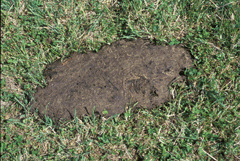
Watch your step! (Courtesy of USDA)
CURWOOD: If you’ve detected a greening of the American mind recently well, a new poll says you’re right. That story’s just ahead on Living on Earth. But first, here’s this week’s note on emerging science, from Paige Doughty.
[SOUND OF COW MOOING]
DOUGHTY: Whoa! Watch your step there, you don’t want to put your foot on that! Or do you?
[THEME MUSIC]
If scientists at Michigan State University have their way you may be walking on floors made of cow manure.
The researchers are calling the new, or, perhaps I should say used, material, “digester fiber.” They’ve combined animal waste with plastic by applying heat and pressure to create the fiberboard. Two prototypes were tested and compared with similar composite products that use wood fiber and plastic. The tests so far show the digester fiberboard equals or surpasses industry standards for strength and stiffness.

Watch your step! (Courtesy of USDA)
The Michigan scientists hope the manure flooring will become one way to sustainably manage waste.
And you don’t have to worry about the smell, the digester fiber flooring is odorless; and the material is cheap to produce.
Now that’s a piece of cow pie you might want to buy!
That’s this week’s note on emerging science, I’m Paige Doughty.
[Sound of Cow Mooing]
Polling the People
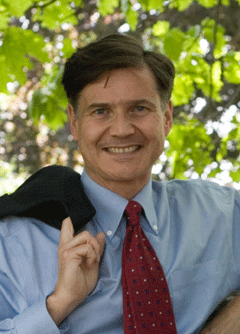
Daniel Esty (Courtesy of Yale University)
CURWOOD: Whoa there Bossy! There’s a new poll out that puts some hard data behind what many people have sensed for some time now—that the U.S. is in the midst of a surge of concern about the environment. The nationwide poll of a thousand adults was conducted for the Yale Center for Environmental Law and Policy. Professor Daniel Esty is the center’s director, and he joins me now. Professor Esty, welcome to Living on Earth.
ESTY: It’s a pleasure to be here, thank you.
CURWOOD: So, what’s the big headline here?
ESTY: The big headline is that the American public cares a lot about climate change. And it seems the folks in Washington haven’t gotten that story yet. But across the board in every demographic group, in every section of the country: East, West, North and South, ah rich and poor, Democrat and Republican we see people care about action on climate change.
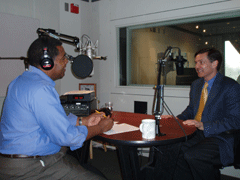
Host Steve Curwood and Professor Esty in the Living on Earth studios.(Courtesy of Ashley Ahearn)
CURWOOD: So going down some of the specific questions you got answered. Ah. here’s one: you asked people if they thought that the country was they were in as much danger from environmental hazards such as air pollution and global warming as it is from terrorists. And the answer was?
ESTY: An overwhelming yes. 63 percent agreed with the statement that the country’s in as much danger from environmental threats, particularly global warming, as it is from terrorism. And obviously they are weighing things that are very hard to compare. But to have 63 percent of people say this is as big a deal as the environment issues as terrorism is striking. And I think it does reflect a sea change in attitudes that’s really emerged in the last year.
We now have people saying that they really do fear this and they care a lot about getting action taken. So you’ve got terrorism obviously as a front burner issue and climate change has emerged right behind it.
CURWOOD: Now, What about gender, how do women respond to climate change as opposed to men?
ESTY: Fascinating issue. We see across the board, on all environmental issues but especially this one in particular, that there’s quite a sharp gender break. And 10 to 15 percent more women want action on every issue including this one than men. We’ve seen it in our prior polls and we see it very strongly here. And maybe it’s a focus on the future. Ah maybe it’s a concern about their children, and their children’s children, and the world they’ll have to live in. It very much is a question here about getting people to think not about today and tomorrow or next year but about where they’re going over the course of their lives.
CURWOOD: How much faith do people put in the President when it comes to stewardship of the environment or action on climate change?
ESTY: Well, the President’s numbers have plummeted to a strikingly low rate. You’ve got only at this point 15 percent of the public that say they have a lot of trust in President Bush on environment. And that is way down from our prior polling and really striking. And frankly the whole Congress, Democrats and Republicans, have seen their numbers plunge and I think it does reflect a frustration with what’s going on in Washington. There obviously is a partisan breakdown. And the public wants action and they’re not getting it.

Daniel Esty (Courtesy of Yale University)
CURWOOD: How much faith are Americans putting into the news media’s coverage of environmental issues and climate change?
ESTY: Well this is another striking piece of development. There’s really been a plummeting degree of confidence in the media, presenting a fair and accurate picture of this issue set. In terms of confidence in the nightly news only 50 percent, down from 69 percent two years ago have confidence that the major outlets will tell us the story straight.
CURWOOD: What happened?
ESTY: Well, I think there has been a growing dissatisfaction with the way the media has presented this issue. There’s been a real effort in the media to try and present it as a complicated story with two sides. And they present opponents of climate change as often as they present those that say it’s an issue. I think the public has now concluded that there’s a real problem here. Whether Al Gore has it all right they don’t care, but the basic contours of the issue they now believe are real and deserve action. And I think they’re tired of media presentations that act as though there’s a real debate going on.
CURWOOD: Were you concerned by any of these results. Did anything here kind of upset you when you saw it?
ESTY: Well I think this poll does show that the American public does care about environment issues. And there’s been a long period of time when the public was thought to be not very focused on environment, not very concerned and I think this suggests that’s wrong. I do think the lack of confidence in the political leadership in this country is worrisome. I do believe that while the business community has an important role to play and each of us as individuals has to step up and do our part it’s extremely hard to organize this kind of a society wide effort without real political leadership. So I remain very concerned about the low rankings of the President and frankly the low rankings of the Congress. If we don’t have good leadership in Washington it’s going to be very tough to make the kind of progress at the speed we need on a very tough issue.
CURWOOD: Daniel Esty is director of the Yale Center for Environmental Law and Policy. Thank you so much sir.
ESTY: It’s a pleasure to have been with you.
MUSIC: Jenny Wilson “Let My Shoes Lead Me Forward’ from ‘Love & Youth’ (Rabid Records – 2006)]
Related links:
- To read the key findings of "The 2007 Yale Center for Environmental Law & Policy Survey on American Attitudes on the Environment" click here.
- And the Yale Center for Environmental Law and Policy Survey
- Daniel Esty's Bio
CURWOOD: Just ahead, writer Barry Lopez takes us to the water under a dry stream bed. It’s part of our Home Ground series on Living on Earth.
[MUSIC: James Asher “Ijeliu” from ‘Mondo Beat: Masters of Percussion’ (Narada – 1998)]
ANNOUNCER Support for the Environmental Health Desk at Living on Earth comes from the Cedar Tree Foundation. Support also comes from the Richard and Rhoda Goldman Fund for coverage of population and the environment, and from you our listeners and from member stations. This is Living on Earth on PRI- Public Radio International.
The Language of Landscape

"Home Ground: Language for an American Landscape," edited by Barry Lopez and Debra Gwartney. (Courtesy of Trinity University Press)
CURWOOD: It’s Living on Earth. I’m Steve Curwood. Baboons are making themselves at home—in homes in the suburbs of Cape Town, South Africa. I’ll take you there in just a minute. But first, a visit to a little piece of our own country.
[MUSIC Daniel Lanois “O Marie” from ‘Arcadie’ (Daniellanois.com - 2005)]
CURWOOD: How well do we really know this place we call home? Forty-five American writers are helping us get to know it a little better in a new book called “Home Ground: Language for an American Landscape.” It’s basically a dictionary of hundreds of unique and unusual features of the vast American countryside. We invited some of the contributors to Home Ground to share definitions with us. And this week it’s Barry Lopez, with his definition of “Blind Creek.”

Home Ground: Language for an American Landscape, edited by Barry Lopez and Debra Gwartney.(Courtesy of Trinity University Press)
[CREEK SOUNDS]
CURWOOD: Barry Lopez is the editor along with Debra Gwartney of “Home Ground: Language for an American Landscape.” We’ll bring you more places from Home Ground in the weeks ahead.
[MUSIC: Amon Tobin “Kitchen Sink” from ‘Foley Room’ (Ninja Tune – 2007)]
Related link:
Home Ground: Language for an American Landscape
Home Invasion, Baboon-style
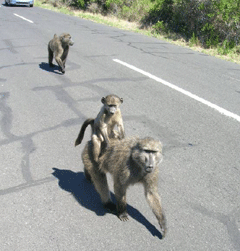
Baboons on the move as monitors drive them from the villages. (Photo: Terry FitzPatrick)
CURWOOD: Increasingly, people who live at the edges of American cities are having close encounters with some big wild animals. It can be a coyote in the park a bear in a dumpster maybe even a cougar on a jogging trail. But of course the problem isn’t unique to the U.S.
[BABOON SOUNDS]
Here in the foothills outside of Cape Town, South Africa, suburban development is leading to more and more conflicts between people and baboons.
[BABOON SOUNDS]
MARRIOTT: In the winter they seem to stop coming ‘round the streets. But in the summer they’re everywhere.
[BABOON SOUNDS]
VENTER: Baboons are fine in their own environment, I know. And I used to love the baboons. I don’t feel the same way anymore.
[BABOON SOUNDS]
JAMES: They’re not domestic animals. It’s not like having a cat or a dog. A baboon is a wild animal. And he lives accordingly. And if you get in his way, if you get in the way and if you corner a big male, he’s going to go for you.
CURWOOD: Residents of Welcome Glen enjoy a tranquil village life, with picturesque views of the ocean and the Cape of Good Hope. But on garbage collection days, the streets here can be chaos.
[HOSE SOUNDS]
CURWOOD: Chris Schulz rolls out his garden hose.
SCHULZ: We just hose them. They are scared of water. On dirt day they come out and they’re a menace.
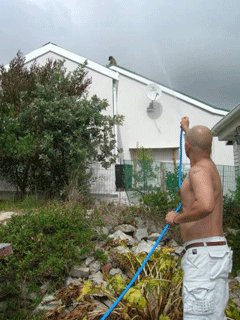
Welcome Glen resident Chris Schulz sprays water to scare a baboon off the roof. (Photo: Terry FitzPatrick)
[HOSE SOUND]
CURWOOD: Curbside trash bins provide an easy meal. Baboons tip them over to nibble on table scraps.
[SCREECH SOUND]
CURWOOD: With piercing, deep-set eyes, rounded snouts, and wiry gray fur, the animals look like tough guys. A fully-grown male can weigh a hundred pounds. Rob and Elizabeth Venter have a slingshot ready as the troupe moves their way.
R. VENTER: That’s “George.”
E. VENTER: No it’s not “George,” it’s “Eric.”
R. VENTER: Well it’s either “George” or “Eric.” It’s one of the two alpha baboons. They’re really big and they attack you. One time one of my friends held up a big stick to it, and “George” grabbed it out of his hand and chased him down the road with the stick.
CURWOOD: Baboons have long foraged in gardens and garbage dumps. But in recent years, animals like “George” have grown more adventurous, seeking supper inside people’s homes.
E. VENTER: He’s very aggressive. And he came into my back sliding door, and suddenly he was right there on my kitchen counter in front of me. And I just said: “go, go” like that. And he went: “argh” to me.
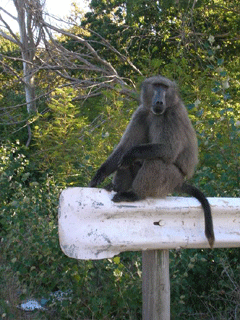
Baboons looking at the village, ready to raid!
(Photo: Terry FitzPatrick)
E. VENTER: No, I jumped back, then I ran out of the house, and called for help. And a neighbor came in with a shovel and he went out. But it was very, very scary.
[DOG BARKING]
CURWOOD: Welcome Glen is one of several neighborhoods battling the baboons. A dozen troupes with more than 350 animals live in nature preserves on the outskirts of Cape Town. The troupes vary in size from one-dozen to three-dozen members, and not all of them raid nearby homes. But everyone living near the parks has a tale to tell.
VOLBRECHT: Well they’ve cost us 25,000 rands in repairs to this house. On the back side, there’s a roof that they’ve broken through. They ended up inside the house in the ceiling.
CURWOOD: Now, more than three thousand U.S. dollars later, Carlo Volbrecht has concluded that many of the animals have grown comfortable in both natural and human environments.
VOLBRECHT: Baboons have become so used to people. And the problem is when they get that relaxed around people, they chase you away from your barbecue in the back, help themselves, and then leave when they’re done. And you’ve go to sit inside your house looking at them.
[WHISTLING AND CLAPPING SOUNDS MAN YELLING]
CURWOOD: The growing conflict between people and baboons has prompted a new type of neighborhood watch. Teams of trained wranglers now respond to baboon raids. They help people cope and also try to keep the primates out of trouble.
[WRANGLING SOUNDS]
CURWOOD: By clapping, shouting and whistling, this three-man team begins to nudge the troupe out of the village and into a grove of pine trees.
MJEMBU: We make a noise like: whoah, whistle, whistle. They know what’s going on. They must go. Whoah, whoah, go, go, whoa, whoah.
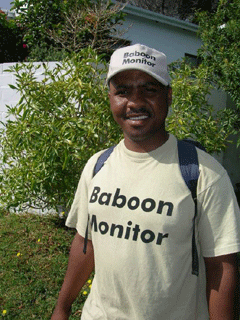
Jerry Mjembu is a monitor for Baboon Matters. (Photo: Terry FitzPatrick)
CURWOOD: On this morning Jerry Mjembu is having a tough time. The problem: a female nestled high in a tree, cradling a tiny bundle of fur.
[MOM & BABE BABOON]
MJEMBU: She got a new baby.
CURWOOD: Ahh.
MJEMBU: Yeah, this morning.
[EATING PINE NUTS]
CURWOOD: The troupe will not leave a mother and newborn behind, though most members eventually settle into the forest to eat pine nuts while the monitoring team guards the village. Eighteen trackers are now working as part of this wildlife management project. It’s funded by a public-private partnership, and run by an animal welfare organization called “Baboon Matters.” The founder is conservationist Jenni Trethowan.
TRETHOWAN: Baboons are highly, highly intelligent creatures. So a lot of the conflict is because they very quickly suss out a situation. So if the rewards are high they’ll take the risk. And of course, as more and more people are moving into their areas they are sussing out that there’s easy food to be gotten from humans, either through our waste or through fruit trees or through gaining entry to houses. So there’s still plenty of food for the remaining baboons on the mountains, but it’s just much easier for them to come down into the villages, which has always been in their home ranges and their forage areas and get much easier food.
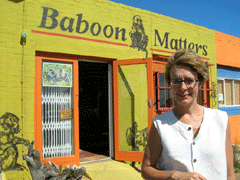
Conservationist Jenni Trethowan monitors baboons from her office in Cape Town suburbs. (Photo: Terry FitzPatrick)
CURWOOD: Now, what do we know about the culinary tastes of baboons? What do they like in the wild, and then what do like when they get the people food?
TRETHOWAN: They’ve got an incredibly diverse range of tastes. Um, here we can see them this morning they’ve been eating the pine nuts. So they make use of about 250 to 260 different plants on the mountain. That’s everything from the bulbs, the roots, the leaves, the flowers of certain species. And now you’ll see them catching insects, very quickly.
When they come into the village, basically most of our human foods. You’ll see if they get into a kitchen they’ll go through the ranges quite quickly. One of our young male baboons has been named spaghetti by the monitors and that’s because he has a real love of spaghetti. (laughs) So they’ve definitely got taste preferences but they’re very adaptable.
[BABOON SOUNDS]
[WRANGLING SOUNDS]
CURWOOD: The monitors work year-round to herd the animals away from people in the first place. Statistics show they’ve been remarkably effective. But they can’t be everywhere, and Trethowan says hundreds of homes have been invaded. There’ve been newspaper stories about baboons confronting diners at local restaurants, and mauling a four-year old boy at a campground.
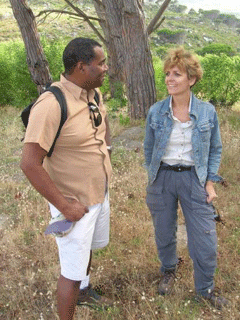
Steve Curwood and Jenni Trethowan hang out with the baboons. (Photo: Terry FitzPatrick)
[BABOON WALK FOOTFALLS]
CURWOOD: While the monitor teams continue their work to keep baboons in the wild, the Baboon Matters project has launched an effort to prove that wildlife can benefit the local economy.
MANELI: So what is going to happen when we come up there to the baboons, maybe the baboons are going to fight. There is nothing they are going to do with us. They are going to do their thing.
CURWOOD: This is baboon tourism. Small groups of visitors are guided into the hills for a two-hour intimate experience. The guide is Siphelo Maneli who says his mother’s tribal name means “female baboon.” He regards the animals as cousins.
[BABOON SOUNDS]
MANELI: This is “Georgie,” the alpha male of this group. As you can see, the old man is surrounded by family. We can come up.
[WALKING SOUNDS]
MANELI: Where you see the old man is where you will see the rest of the females and the babies. They trust the old man, they trust “Georgie” very much.

Guide Siphelo Maneli explains baboon behavior as a baboon watched from the treetop. (Photo: Terry FitzPatrick)
CURWOOD: Maneli explains the troupe’s family structure and behavior.
MANELI: You hear the baby go “ah, ah.” The baby wants to have breast feeding.
[BABOONS PLAYING ON WALK]
CURWOOD: Unlike their behavior in the village, the baboons here seem playful and relaxed. They mingle freely with the tourists.
MANELI: You hear that one? That sound means that one wants to mate. And that one is going to go down and mate with this one. And we saw the answer from the calling.
[BABOON MATING CALLS]
CURWOOD: People have been coming on these walks for more than a year to watch baboons doing what comes naturally. Many are overseas tourists. But some, like Bruno Marchand and Anne Manyne, are locals.
MARCHAND: It’s things like this that really put you in touch with where you are. Because we live in an urban environment and yet here is a group of social animals different to us, and they’re doing their thing.
[BABY CHIRPS FOR MILK]

Baboons on the move as monitors drive them from the villages. (Photo: Terry FitzPatrick)
MANYE: When I was a teenager and I was walking in the mountains, we saw baboons all the time and we saw leopards and now there’s nothing. So I’m incredibly pleased that here people are actually keeping them going and, and, make it possible for the baboons to live next to people.
[TOWN CROWD SOUND]
CURWOOD: No one is upset with the presence of baboons in Cape Town’s natural areas. But there’s a growing sense of frustration over the repeated raids on homes.
NOBLE: Okay I think we’re going to start.
CURWOOD: Graham Noble has called a special meeting of the taxpayers association in the village of Scarborough.
NOBLE: Ladies and Gentlemen, welcome. We’ve had a very bad month here in Scarborough with, ah, baboons. We thought May last year it couldn’t get any worse. In fact it got a lot worse. We’re really at our wit’s end to know what is the best thing to do. And that’s why we’ve summoned you here, to discuss the options our community has in facing up to the challenge.
[TOWN MEETING SOUND]
CURWOOD: Many homeowners are angry. Roddy Bray says baboons have ripped-open locks and windows.
BRAY: We now have baboons who are breaking and entering. And I think that the baboons have to be seen as, as rogue elements. If they were humans we would have had them arrested and locked up and sent away.
CURWOOD: The alpha male raiding Scarborough is nick-named “William the Conqueror.” And he’s frightened parents like Pierre de Villiers, who stands in the back of this meeting holding his young son.
DE VILLIERS: This is a boy who’s traumatized. He’s scared to walk outside of our house. This guy William should go.
CROWD: Here, here. Definitely.
DE VILLIERS: He should go because he’s dangerous.
[CROWD DEBATES]
CURWOOD: The idea of killing or relocating the most troublesome animals sparks intense debate. Some residents propose warning sirens or electric fences instead. Others suggest radio collars to track the troupes, and feeding stations inside the park to lure baboons away from people. Many residents though, like Ushka Mrkusic call for calm.
MRKUSIC: I must say that even in my closest encounters, where I’ve been hostage in my kitchen by alpha males, they’ve never damaged me. And if you respond in the moment without making the baboon feel threatened, the baboon will leave without creating any damage. And I think that people are totally overreacting to the situation.
[APPLAUSE]
CURWOOD: Government zoologists say the solution lies more with people than baboons. Urban development in Cape Town is sprawling into wild country, and many homeowners have failed to baboon-proof their property. Some tourists and animal lovers are feeding them handouts. Gavin Bell is the regional wildlife manager for South African national parks.
[CAPE CITY SOUNDS]
BELL: The animals have become familiar with humans. They’re not afraid of humans. And they’ve been fed by humans. Humans have allowed them to move into their houses because they haven’t closed the doors or closed the windows. So they’ve become habituated and familiarized with humans. So what you’ve got to do is you’ve got to break that.
CURWOOD: Wildlife managers are asking for a bigger budget to educate local residents about steps they should take, such as cutting down backyard fruit trees, installing burglar bars on windows and putting locks on garbage cans. Bell says it’s the only long-term solution for living with wildlife.
BELL: Once humans recognize and realize that we’re actually in their place, and that we need to pay proper respect to them, half the battle is won.
[WRANGLING SOUNDS]
CURWOOD: But back in Welcome Glen, as the wranglers struggle to sweep a troupe out of the village, homeowner Carlo Volbrecht isn’t waiting for a long-term solution. He’s giving up.
CURWOOD: I see your house is for sale, anything to do with baboons?
VOLBRECHT: It’s not the only reason, but it’s, we’ve had enough. We’ve got a little one, two years old, and he can’t play in the garden. It’s become unacceptable. So it’s one of the reasons we’re leaving.
[HERDING SOUNDS]
CURWOOD: A few doors down, Denzyl James has a different fear. In the past year, 19 baboons have been shot, run down by cars, poisoned or killed in traps set by residents. It’s illegal to hurt the animals, but James is worried the vigilantes will push local troupes toward extinction.
JAMES: I think we’ve got to look after the baboons. But if they stay in this area, there’r gonna be a lot more fatalities and that’s the sad part. That’s sad.
CURWOOD: There’s not room for people and baboons in the same place, huh?
JAMES: No, that’s the truth.
[WRANGLING SOUNDS]
CURWOOD: Our report on the baboon battle of Cape Town was produced by Living on Earth’s Terry FitzPatrick.
[MUSIC: Ibrahim Ferrer “As Time Goes By” from ‘Rhythms Del Mundo: Cuba!’ (Universal/Ape Vision – 2006)]
Related links:
- Table Mountain National Park
- Baboon Matters
Next time on Living on Earth…
CURWOOD: Shortly before he died last year, famed Cuban musician Ibrahim Ferrer recorded one last song.
[MUSIC: Ibrahim Ferrer “As Time Goes By” from ‘Rhythms Del Mundo: Cuba!’ (Universal/Ape Vision – 2006)]
CURWOOD: Ibrahim Ferrer singing “As Time Goes By” on a new album of pop hits given a Cuban treatment on a benefit record for climate change awareness.
Rhythms del Mundo Cuba next time on Living on Earth.
Living on Earth is produced by the World Media Foundation. Our crew includes Ashley Ahearn, Eileen Bolinsky, Bruce Gellerman, Ian Gray, Ingrid Lobet, Emily Taylor, Peter Thomson and Jeff Young - with help from Bobby Bascomb, and Kelley Cronin. Our interns are Paige Doughty and Meghan Vigeant. Dennis Foley is our technical director. Alison Lirish Dean composed our themes. You can find us anytime at l-o-e dot org. I’m Steve Curwood. Thanks for listening.
ANNOUNCER: Funding for Living on Earth comes from the National Science Foundation, supporting coverage of emerging science. And Stonyfield Farm, organic yogurt, smoothies and milk. Ten percent of profits are donated to efforts that help protect and restore the earth. Details at Stonyfield dot com.
Support also comes from you our listeners, the Ford Foundation, the Oak Foundation, and the Saunders Hotel Group of Boston's Lennox and Copley Square Hotels. Serving you and the environment while helping preserve the past and protect the future, 800-225-7676.
ANNOUNCER2: PRI, Public Radio International.
Living on Earth wants to hear from you!
Living on Earth
62 Calef Highway, Suite 212
Lee, NH 03861
Telephone: 617-287-4121
E-mail: comments@loe.org
Newsletter [Click here]
Donate to Living on Earth!
Living on Earth is an independent media program and relies entirely on contributions from listeners and institutions supporting public service. Please donate now to preserve an independent environmental voice.
NewsletterLiving on Earth offers a weekly delivery of the show's rundown to your mailbox. Sign up for our newsletter today!
 Sailors For The Sea: Be the change you want to sea.
Sailors For The Sea: Be the change you want to sea.
 The Grantham Foundation for the Protection of the Environment: Committed to protecting and improving the health of the global environment.
The Grantham Foundation for the Protection of the Environment: Committed to protecting and improving the health of the global environment.
 Contribute to Living on Earth and receive, as our gift to you, an archival print of one of Mark Seth Lender's extraordinary wildlife photographs. Follow the link to see Mark's current collection of photographs.
Contribute to Living on Earth and receive, as our gift to you, an archival print of one of Mark Seth Lender's extraordinary wildlife photographs. Follow the link to see Mark's current collection of photographs.
 Buy a signed copy of Mark Seth Lender's book Smeagull the Seagull & support Living on Earth
Buy a signed copy of Mark Seth Lender's book Smeagull the Seagull & support Living on Earth

